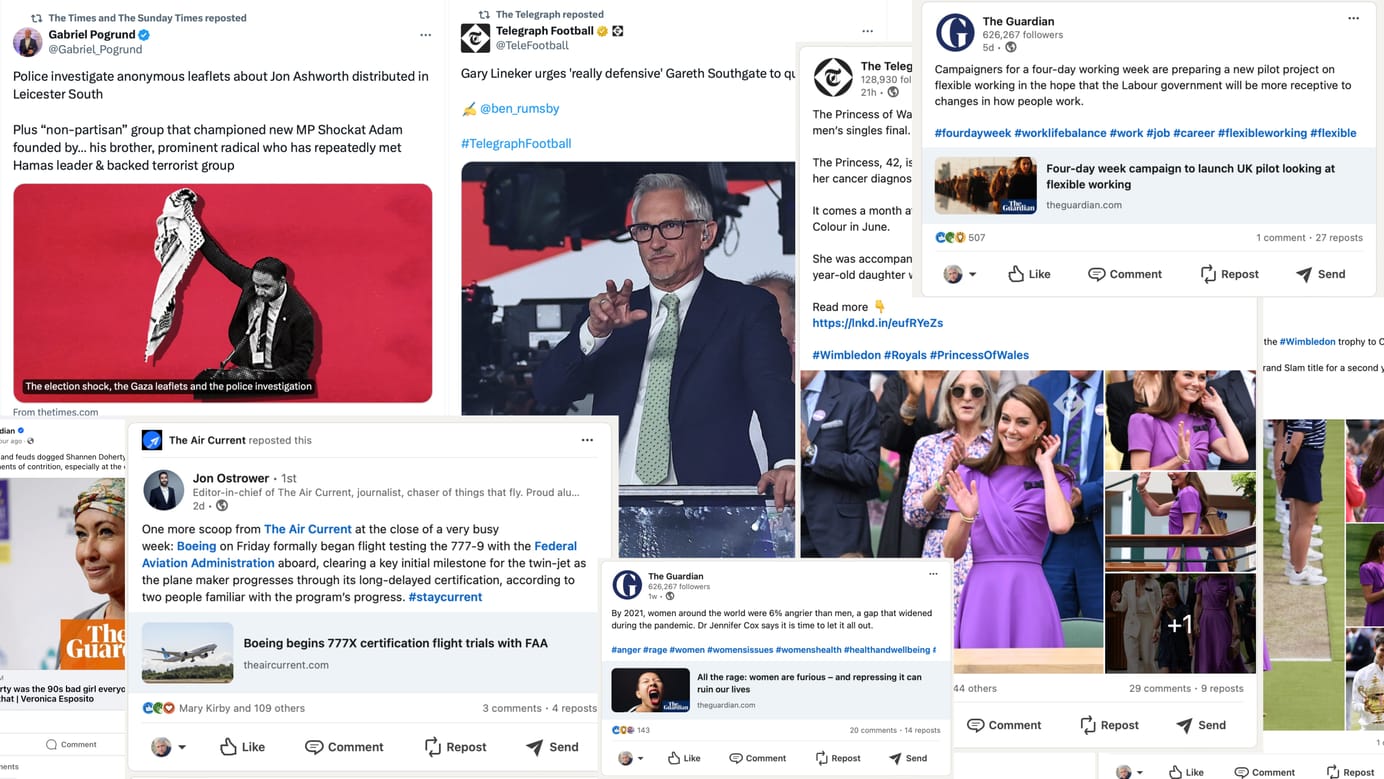
Digital News Report 2023: the social challenge for audience growth
2023’s Reuters Institute Digital News Report makes for grim reading. But, for the savvy, audience-centric journalist, there’s opportunity here, too.
It’s that time of the year again: the Reuters Institute publishes its linchpin piece of research about the current state of the news business globally: the Digital News Report 2023. I’ve had access to a preview copy — and it’s a whopper this year. And it’s a bit scary. The overall picture is of an industry that’s failing. Oh, not necessarily financially, but in impact. Trust is declining, and people are shifting away from websites just as they shifted away from print.
The digital environment is changing around us faster than we can adapt. As Reuters Institute director Prof Rasmus Kleis Nielsen puts it:
Whether or not legacy media feel they have completed their initial digital transformation from print- or broadcast-focused to digitally focused brands with a compelling news website and app, they now face a continual transformation of digital as generations come of age who eschew direct discovery for all but the most appealing brands, have little interest in many conventional news offers oriented towards older generations’ habits, interests, and values, and instead embrace the more participatory, personable, and personalised options offered via platforms, often looking beyond legacy platforms to new entrants (many of whom drive few referrals to news and do not prioritise news).
Ooooh. “Continual transformation of digital”. I’m slightly too excited right now. This is like catnip to me. Continual transformation means opportunity: the chance for new players to rise and for older players to become something quite different. So, while much of the report looks like bad news, there’s a silver lining deep in there that the bravest journalists can reach for.
Today, I’m going to concentrate on a couple of the findings that leapt out at me because they’re most central to audience work. I hope to come back to other points raised in the coming days, but let’s see how my week pans out, shall we?
Social is very much alive as a news channel
If you’ve been reading the journalism press over the last year, you’d have come away with the impression that the age of traffic from social is over. If you squint very hard, that’s true – as long as you focus on the word traffic. Because the one thing that the 2023 report makes very clear is that social is only growing in importance for news.
Here’s a rather upsetting graph to make that point:
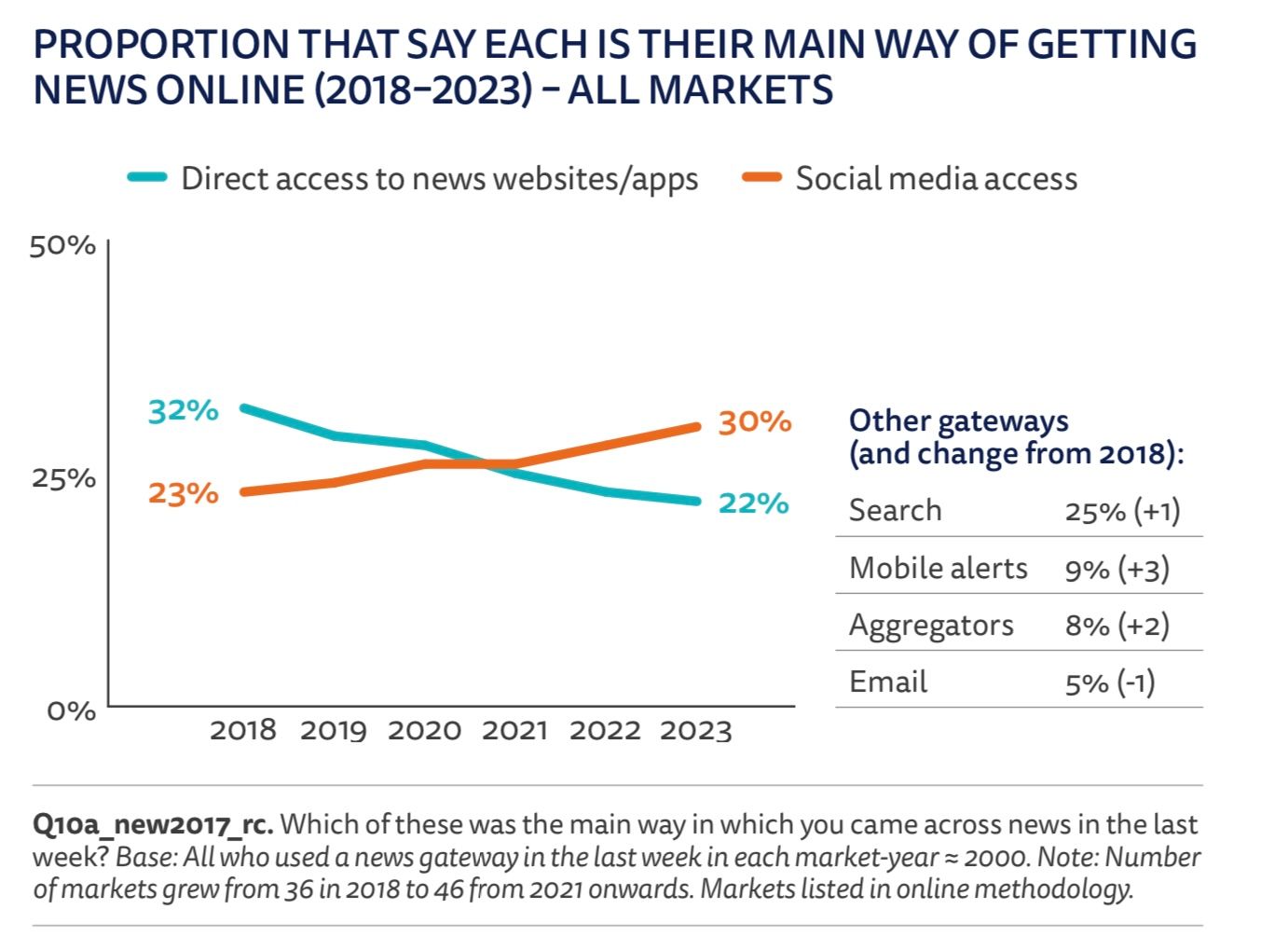
Direct access to news websites and apps is plunging, and social on continuing to rise. If you wonder why the audience team over in the corner keeps growing — that’s why. We need these people to keep putting our work in front of a platform-focused audience. (And I’ll keep on training them for you at City…)
However, their job isn’t going to get easier any time soon. The balance of platforms is changing. The stable state we’ve had for the best part of a decade is over. But the changes might not be what you think. Time for another graph from the report:
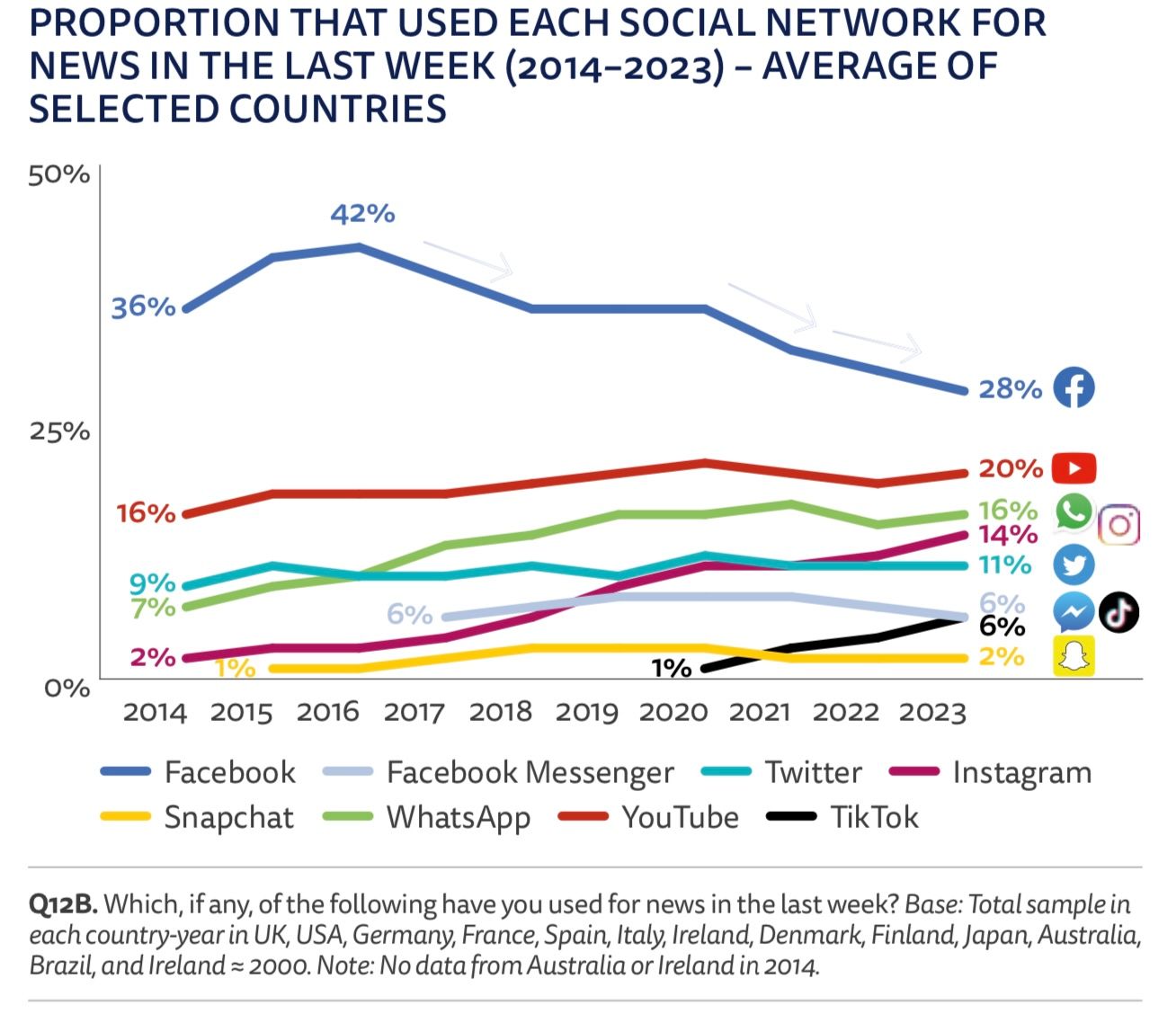
What can we learn from this?
- Facebook is still the biggest player, but it’s seriously declining.
- We’re still massively under-utilising YouTube. We need to get better at that platform — and soon.
- Instagram remains much bigger than TikTok and is still growing.
- There are two messaging apps on there. And both are growing.
- Elon’s offing around with Twitter hasn’t undermined it as a news source — yet. I bet the 2024 report will be interesting on that front.
That means you’re going to need a multi-skilled audience team. You can’t just fall back on Facebook and Twitter — and you will have to be creative in finding ways of bringing people back to your main product from challenging platforms like the ‘gram, TikTok and messaging apps.
And the necessity for that becomes even clearer when you look at the social media habits of the younger demographic:
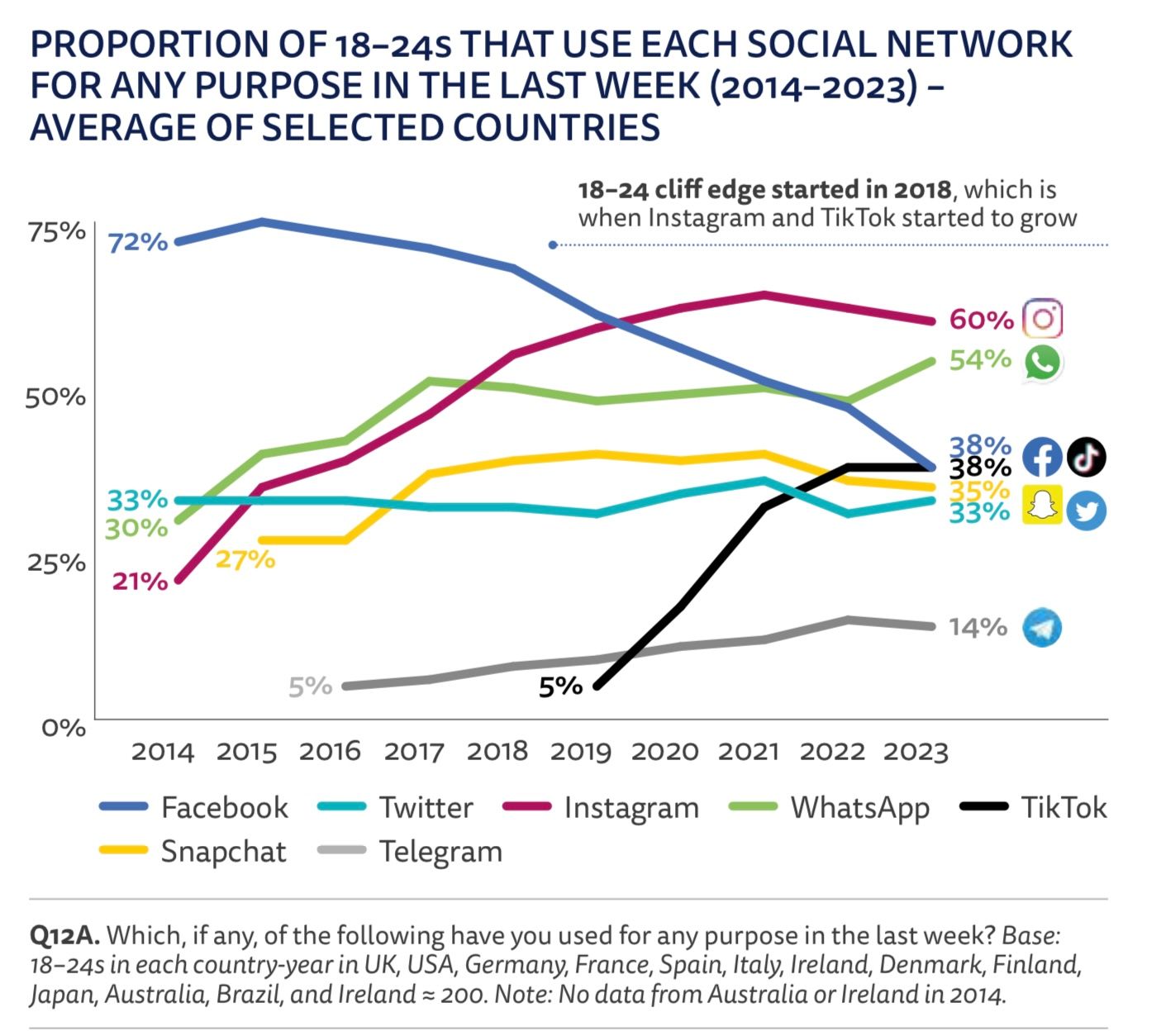
Some fascinating stuff here. TikTok has flatlined among its key demographic. And Instagram is much bigger here – even if it is seeing a small decline. And those pesky messaging apps are in there, too.
As I said, the balance of platform power is shifting, and that means our skillset needs to change too.
The age of the journalist influencer
I suspect at least some of the answers we need can be found in this visualisation. Look how central personalities are to the emerging platforms:
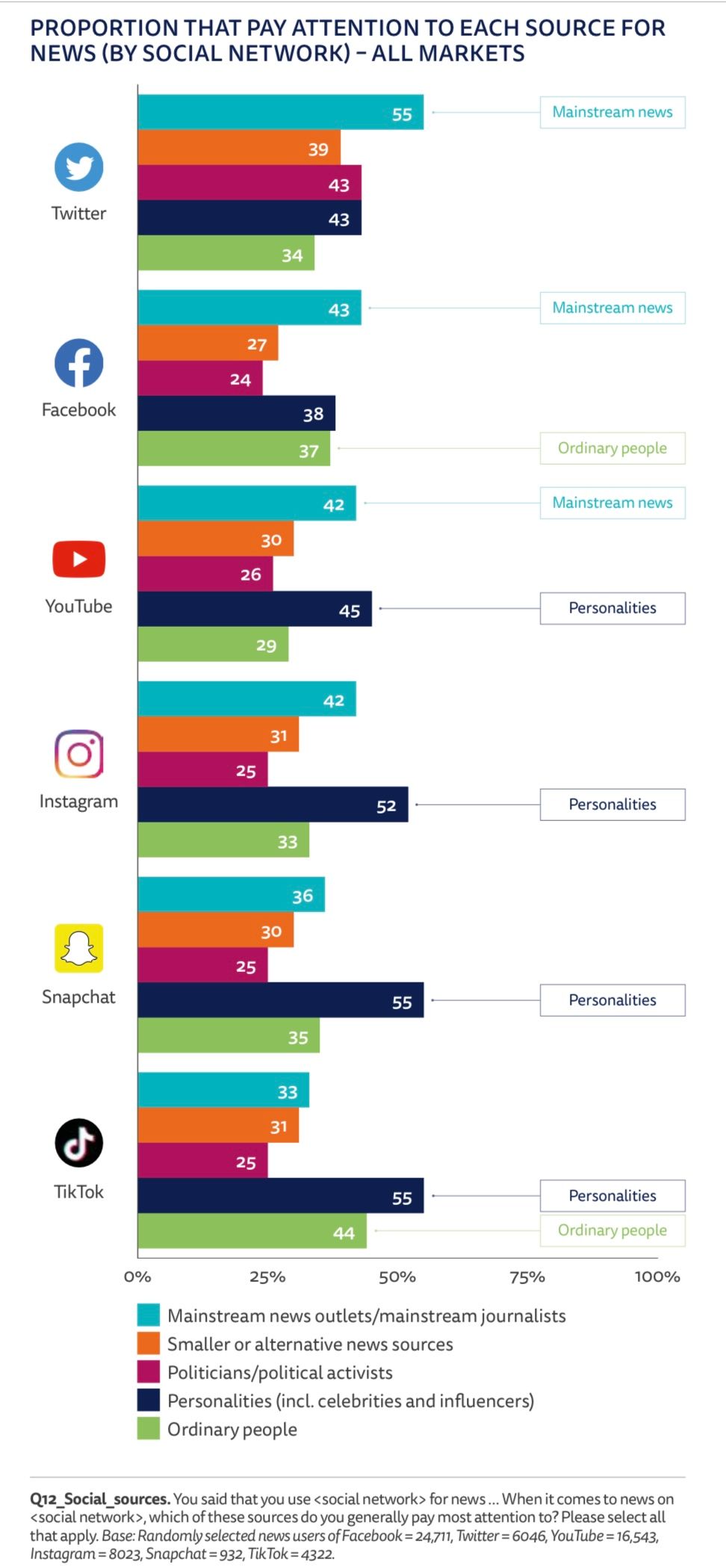
They dominate everywhere but the old world of Twitter and Facebook. Just working the platforms, via a combination of psychology and algorithm insight, is no longer enough. You’re going to need to find faces to put on camera, who are relatable, engaging and can build trust. That’s a big shift, and it will bring the traditional worlds of broadcast and newspaper journalism closer together.
Community gets secret
Here are a couple of quotes from report co-author Nic Newman that need looking at together:
We find that many measures of open participation, such as sharing and commenting, have declined across countries, with a minority of active users making most of the noise.
And:
Other networks such as Discord (15%) and Twitch (12%) are also more widely used by this younger demographic.
The increased polarisation and hostility of many of the public-facing platforms is clearly driving people into more closed communities, where they feel safer and freer to talk about issues, without random people “sealioning” into their discussions. Or running the risk of being “cancelled” for a quote taken out of context. And that’s reflected in other stats: across markets, only around a fifth (22%) post and comment on the news online, with around half (47%) not participating in the news at all. Well, publicly, at least.
That’s behind the rise of the messaging apps I commented on earlier. And it also means that if you don’t know what Twitch and Discord are — I suggest you find out, pronto.
And, to be fair, Nic identifies this trend clearly:
Looking back, we can detect a period of peak sharing in some markets between 2016 and 2019, primarily driven by Facebook and by divisive events such as the election of Donald Trump in the United States, the Brexit referendum in the United Kingdom, and the vote on Catalan independence in Spain. But since then, online participation has shifted to some extent into closed networks such as WhatsApp, Signal, Telegram, and Discord, where people can have private or semi-private conversations with trusted friends in a less toxic atmosphere.
Social is becoming community again
There’s work to be done here, both in finding an engaging with those more hidden communities in a way that benefits both us and them, but also in thinking about how we can host and facilitate those communities. This is precisely the sort of work I was doing 15 years ago – but then online communities are developing a rather cyclical pattern. They rotate between more open spaces and more closed ones. Arguably, we’re in the third cycle of this, which means the switch around happens about once a decade. And we're living through one now.
And, as I suggested last week, when there’s a period of change, there’s a period of opportunity. We’re in that again. The stable audience state of the 2010s, where we could do some SEO, put links on Facebook, and the traffic would arrive, is dead. It probably died at the end of the last decade, but the pandemic hid that from us. As we moved into the mid-2020s, it’s clear the dynamics have changed irrevocably.
Those publishers who have invested in a range of audience skills should be able to adapt — if they have the courage and financial headroom to experiment. Those that haven’t will find building a loyal audience ever harder as the social media native generation ages.
To quote Rasmus again:
There are no reasonable grounds for expecting that those born in the 2000s will suddenly come to prefer old-fashioned websites, let alone broadcast and print, simply because they grow older.
There’s only one way to go: forwards into an age of more complex online communities. This could be fun.
And that, folks, was just one major thread in the report. Grab your own copy now, and I’ll see you all again tomorrow for some thoughts about video, trust, and news avoidance…
Sign up for e-mail updates
Join the newsletter to receive the latest posts in your inbox.


